Chevrolet Traverse Vs GMC Acadia: Which Crossover is Right for You?

These two GM crossovers offer two very different solutions to the same problem.
In their previous generation, the Chevrolet Traverse and GMC Acadia were essentially twins wearing different Halloween masks. That changed with the current generation however, with the GMC shrinking by a few inches in every direction. They’re both three-row crossovers, but together they now target both the mid-size (GMC) and full-size (Chevrolet) crossover market. Different trim lineups and even drivetrains mean each one of these big boys can satisfy different buyers’ needs.
Get a Quote on a New Chevrolet Traverse or GMC AcadiaSo which one is best for your needs then, dear reader? Read on for the full breakdown.
Cabin Space
Traverse: The Traverse is one of the largest vehicles you can buy without moving to a truck-like, body-on-frame chassis. That affords it acres of space inside, and seating for up to eight. Once you move up to the fancier trims, second-row captain’s chairs are either optional (LT) or standard (RS, Premier, and High Country).
Chevrolet quotes 41.3 inches (1,049 mm), 40.0 inches (1,016 mm), and 38.2 inches (970 mm) of headroom from up front to the way-back. Models with a moonroof shave around an inch (25 mm) off the first two rows. Legroom isn’t far off the space for noggins either: we’re talking 41.0 (1,041 mm), 38.4 (975 mm), and 33.5 inches (850 mm) for each row, respectively. That’s not far off the bigger Tahoe, which has the same 120.9-inch (3,071-mm) wheelbase.
Acadia: Right off the bat, the Acadia gives up one seat to the Chevy. You’ll find a maximum of seven perches in the GMC, though like its larger sibling, there is the option of second-row captain’s chairs.
Naturally, since the Acadia is smaller in nearly every direction, it’s comparatively tighter than the Traverse. The operative word here is “comparatively,” though. The Traverse gives up around an inch (25 mm) in headroom across all three rows. Legroom is identical for the driver and whomever rides shotgun, while the Acadia beats the Traverse for second-row stretch-out space, totalling 39.7 inches (1,008 mm). On the flip side, way-back passengers have just 29.7 inches (754 mm) to work with. Short folks preferred, then. Hip- and shoulder-room are both good for adults, though slightly less than the Traverse, since the Acadia is three inches (75 mm) narrower.
SEE ALSO: Mazda CX-9 vs Toyota Highlander ComparisonBottom Line: Both of these big family haulers offer some of the most spacious interiors in their segments. Math can be hard, but it isn’t here: the Traverse is just bigger, and so it offers more space.
Cargo Space and Towing
Traverse: With all three of its rows upright, the Traverse will eat up to 23.0 cubic feet (651 liters) of family flotsam. Drop the third row and space more than doubles, to 57.8 cubes (1,637 L). Finally, if you convert your Traverse to a two-seater—it’s practically a Corvette now, right?—you’ve got a cavernous 98.2 cubic feet (2,780 L) to play with. Set up this way, the Traverse has nearly eight feet of load floor for larger items.
Towing capacity is up to 5,000 lb if properly equipped.
Acadia: The story is the same here as it was for the interior: the Acadia posts numbers that are shy of its larger sibling. There are just 12.8 cubic feet (362 L) behind the third-row seats. Drop ’em and you’ve opened the Acadia up to 41.7 cubes (1,181 L), a little over 60 percent what the Traverse is capable of. With both rows flat, we’re talking 79.0 cubic feet (2,237 L).
With either four-cylinder engine option, towing is limited to just 1,000 lb in the Acadia. Equipping the 3.6-liter V6 and the trailering package bumps the number up to a healthier 4,000 lb.
SEE ALSO: Chevrolet Traverse vs Chevrolet Tahoe ComparisonBottom Line: Hey look, it’s the same as the last category: the bigger rig wins.
Tech and Features
Traverse: The base trim features eight-passenger seating, 10 cupholders, six USB ports, a 7.0-inch infotainment system, keyless access, a WiFi hotspot, and OnStar. A larger infotainment screen, as well as embedded navigation, is available higher up the trim walk. Moving up also opens access to the large, two-pane power sunroof.
Depending on trim, Traverse buyers can also enjoy such niceties as a Bose sound system, power liftgate, power-folding third row, heated and ventilated front seats (with memory function), second-row heated seats, and a heated, power-adjustable steering wheel. A high-def, 360-degree camera and digital rearview mirror are also available. A wireless charge pad available on the Premier and High Country.
A rear-seat entertainment package, including two screens and your choice of DVD capability or not, is available on most trims.
Acadia: The Acadia’s base trim closely mirrors the base Traverse. It’s a case of plus and minus 1s: an 8.0-inch infotainment screen, one less seat (now seven), and one less USB port (now five). By and large the rest of the available features are the same, including the two-pane sunroof, heated and ventilated memory seats. The major exception is the Chevy’s power-folding third-row: it’s all manual here. Wireless charging is available from the SLE onward, which is useful, as the Acadia includes wireless support for Android Auto and Apple CarPlay.
GMC buyers do get access to some unique features, however. A head-up display is available on most trims, for starters—it comes bundled with the surround-view camera. The fancy-pants Denali also offers Adaptive Ride Control. The system adjusts the suspension’s damping every 2 milliseconds for a smoother ride.
SEE ALSO: 2021 Cadillac Escalade Review: Ghost ProtocolBottom Line: You can’t go wrong with either option here, since both the Traverse and Acadia are 95 percent the same. The available HUD and adaptive suspension on the GMC has us leaning that way.
Powertrains
Traverse: Traverse keeps things simple underhood: the only engine option is GM’s familiar 3.6-liter V6, hooked up to a nine-speed automatic transmission. The pair is good for 310 horsepower and 266 lb-ft of torque. Buyers have the choice of front- or all-wheel drive.
Acadia: Higher trims of the Acadia use the same drivetrain combo as the Traverse, though the GMC boasts 5 more lb-ft. Lower trims make do with a 2.5-liter inline-four, producing just 193 horsepower and 188 lb-ft of torque. An optional 2.0-liter turbocharged engine strikes a balance, offering 228 hp and a healthy 258 lb-ft of maximum torque. All three engines are available with front-wheel drive; AWD is limited to the turbo-four and V6. The off-road-oriented AT4 features a unique twin-clutch AWD system, as well.
Bottom Line: The GM V6 is a good unit for moving either of these family haulers. The Acadia simply has more options, though.
Fuel Economy
Traverse: In front-drive form, the Traverse will post 18 mpg city and 27 mpg highway, for a combined 21 mpg. With a 19.4-gallon fuel tank, you’re looking at a cruising range of anywhere between 349 and 524 miles. The AWD model shaves its mpg ratings to 17/25/20, respectively, but a larger 21.7-gallon fuel tank gives it around 20 extra miles of single-fill range.
Acadia: Thanks to its three available engines, the Acadia covers a wider range of fuel efficiency. With the same V6 as the Traverse, the front-drive Acadia is capable of 19 mpg city, 27 mpg highway, and a combined 22 mpg. The base 2.5-liter four-cylinder has the same highway rating, yet bumps its city consumption to 21 mpg, for an average of 23 mpg. The turbocharged four-pot is the most economical at 22/29/25 mpg, respectively.
The 2.5-liter is unavailable with AWD. Opting for AWD keeps the city ratings the same on both the V6 and turbo-four, and 1 and 2 mpg off the highway score, respectively. Range is similar to the Traverse, with the turbo-AWD combo posting the highest numbers (484 to 594 miles).
SEE ALSO: The 8 Best Winter Tires and Why You Absolutely Need ThemBottom Line: The Acadia’s smaller size gives it the edge in V6 form, and the lead extends further with the other available engines.
Safety
Traverse: Traverse buyers need to pony up some extra cash for any active driver assists. Chevy Safety Assist becomes an option on the mid-level LT trim. It includes automated emergency braking, foward collision alert, pedestrian detection, lane-keep assist and IntelliBeam. Blind-spot monitoring, rear cross-traffic alert, and rear parking assist are part of a separate option package. All of the above is standard on the RS and higher trims, which also throws in a 360-degree camera and a digital rear-view mirror. Adaptive cruise control is only available on the High Country.
The NHTSA rates the Traverse five stars in its crash tests. The SUV doesn’t earn an IIHS Top Safety Pick rating.
Acadia: As they would with the Chevy, Acadia buyers need to spend more on lower trims to add the active driver assists, dubbed GMC Pro Safety Plus here. The suite does become available from the SLE FWD onwards however, and then standard on SLE AWD up. In addition to what the Chevrolet suite includes, the GMC adds front and rear parking assists. An important distinction, however: lane-change alert and rear cross-traffic alert are standard on all Acadias. The trade off is that the surround-view camera and digital rear-view mirror remain optional, even on the Denali.
Both the NHTSA and IIHS rate the Acadia the same as the Traverse—no surprise there.
Bottom Line: Neither one of these crossovers scores well on the safety front, requiring quite a lot of extra cash before most active driver assists are equipped. The Acadia makes them standard earlier in the trim walk, and doesn’t require a second options package, since lane-change and rear cross-traffic alerts are standard across the board. That makes it the winner here.
Styling
Traverse: The Traverse is a handsome, if understated, big crossover. It employs the usual Chevrolet design cues, with thin head- and taillights, clean lines, and a double-decker grille. Its car-like styling separates it from the truckish Tahoe. For 2022, the Traverse will see a facelift, giving it a squintier visage akin to the smaller Blazer.
Acadia: Shorter length and a more upright nose gives the Acadia a tougher look than its sibling. There’s a liberal sprinkling of chrome on the exterior, and buyers looking for more bling can opt for the high-falutin’ Denali trim. An available AT4 trim gives the Acadia a tougher, off-road-ready look.
SEE ALSO: 2021 Chevrolet Tahoe First Drive Review: Raising the StandardBottom Line: Beauty, eye, beholder—you know the drill.
Pricing
Traverse: Chevrolet kicks off the Traverse lineup with the front-drive L for $30,995, including destination. The L doesn’t include any of Chevrolet’s active driver assists, however—and neither does the $34,095 LS trim, either. The LS does offer numerous exterior trim packages, plus rear-seat infotainment, and the option of AWD ($2,000). Gaining access to the Chevy Safety Assist (CSA) suite requires at least the LT ($36,595), where it is a $625 option. CSA is standard on the RS ($44,895) onward.
Getting into the fancy end of the lineup, the Premier lists for $46,995 in front-drive trim, while the top-dog High Country will set you back $52,095. At that level there aren’t many options save for the “Hit the Road” Package (roof cross rails and lower assist steps) and rear-seat infotainment.
Acadia: The Acadia lists for the same $30,995 starting price as the larger Traverse. For that money, your only option is the 2.5-liter four-cylinder, which may feel underpowered when you’ve got any passengers along for the ride. The next-level SLE ($34,795) keeps the four-pot, but buyers can upgrade to the familiar V6 for an additional $1,495 outlay. The most affordable way into the fuel-efficient 2.0-liter turbocharged Acadia is the $37,995 SLE AWD. Meanwhile, the $39,995 SLT FWD adds goodies like remote start, powered driver’s seat, heated front seats, and a hands-free programmable liftgate.
The tougher AT4 ($42,295) comes only with the V6 and AWD. At the top of the pile is the Denali, available with front- or all-wheel drive, and the turbo-four or V6. It tops out at $49,495 for the V6 and AWD combo.
It’s important to note that GMC Pro Safety Plus becomes available as an option on the front-drive SLE, but is standard on all trims and drivetrains above that.
Bottom Line: Both of these SUVs start at the same price, which must technically give the edge to the Traverse. It’s more metal and a better engine. Ignoring the fleet-special base trims though, the Acadia offers buyers more choices right around the $40,000 range, and tops out a few thousand less than the ultimate Traverse trim.
Verdict: Chevrolet Traverse vs GMC Acadia
As it turns out, these once near-identical crossovers have gone down different paths. Both offer plenty of space for a reasonable cost, and smooth, road-trip-friendly rides.
Buyers looking for a way to prioritize fuel efficiency or hauling will appreciate the Acadia’s numerous drivetrains. Meanwhile, the Traverse is more suited to large-scale family hauling thanks to its more generous dimensions. Have a serious think about what you’ll be using your three-row crossover for most often, and that should go a long way into making the decision easier.
Become an AutoGuide insider. Get the latest from the automotive world first by subscribing to our newsletter here.

Kyle began his automotive obsession before he even started school, courtesy of a remote control Porsche and various LEGO sets. He later studied advertising and graphic design at Humber College, which led him to writing about cars (both real and digital). He is now a proud member of the Automobile Journalists Association of Canada (AJAC), where he was the Journalist of the Year runner-up for 2021.
More by Kyle Patrick



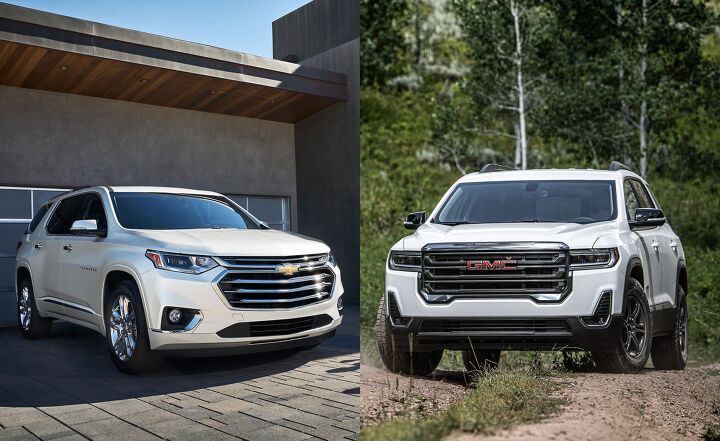





























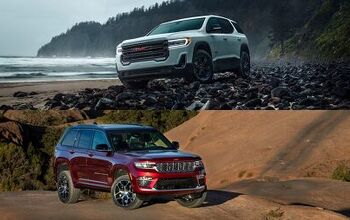
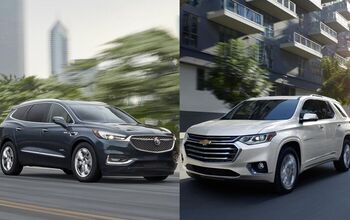
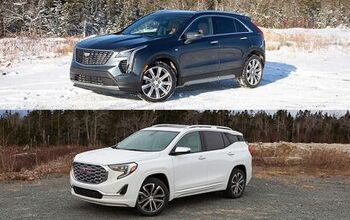
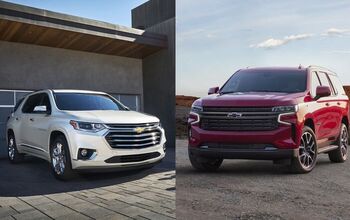












Comments
Join the conversation
Good review, great!0]